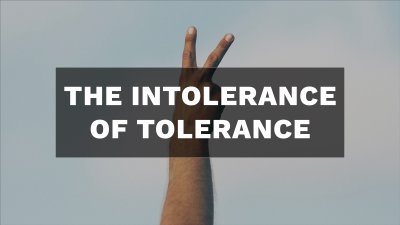
Animated Video
Introduction
Greg Koukl
There is one word that can stop a follower of Christ in his tracks as he seeks to “give an account for the hope” that is in him. That word is “intolerant.” Tolerant people do not think their convictions are right and others are wrong. They are impartial, non-judgmental, and neutral. The cultural creed, “There is no truth,” is often followed by a demand for tolerance. But this appeal self-destructs because it actually asserts two truths that cancel each other out: the “truth” that there is no truth—a clear conflict—and the truth that one ought to tolerate other’s viewpoints. Their confusion serves as a warning that the modern notion of tolerance is seriously misguided.
The Tolerance Trick
Greg Koukl
On this definition of tolerance, true tolerance is impossible. Let me give you a real-life example. A few years back, I spoke to a class of seniors at a Christian high school in Des Moines. I wanted to alert them to this “tolerance trick,” but I also wanted to learn how much they had already been taken in by it. I began by writing two sentences on the board. The first expressed the current understanding of tolerance: All views are equally valid; no view is better than another. All heads nodded in agreement. Nothing controversial here. Then I wrote the second sentence: Jesus is the only way of salvation; all other religions are wrong for rejecting Him. Immediately hands flew up. “You can’t say that,” a coed challenged. “That’s disrespectful. How would you like it if someone said you were wrong?” “Like you’re doing right now?” I pointed out. “But your view is intolerant,” she said, noting that the second statement violated the first statement. What she didn’t see was that the first statement also violated itself. I pointed to the first statement and asked, “Is this a view, the idea that all views are equally valid?” They all agreed. Then I pointed to the second statement—the “intolerant” one—and asked the same question: “Is this a view?” They studied the sentence for a moment. Slowly my point began to dawn on them. If all views are equally valid, then the view that other religions are wrong for rejecting Jesus is just as true as the view that other religions are right for rejecting Jesus. But this is hopelessly contradictory: “All views are equally valid, including the view that all views are not equally valid,” or “All views are equally valid and not equally valid at the same time.” They’d been taken in by the tolerance trick. If this is what tolerance amounts to, then no one can be tolerant because “tolerance” turns out to be contradictory gibberish.
True Tolerance Part 1
Greg Koukl
“Would you like to know how to get out of the trap?” I asked. They nodded. “Reject this distortion of tolerance and return to the classical view.” Then I wrote these two principles on the board: Be egalitarian regarding persons. Be elitist regarding ideas. Egalitarian - think equal. Treat others as having equal value or worth. This first principle is at the heart of the classical view of tolerance. Treat people with equal respect. True tolerance applies to how we treat people, not how we treat ideas. We respect people who hold different beliefs from ours by treating them with courtesy, allowing them a place in the public conversation. Though we may strongly disagree with their ideas, tolerance requires us to be civil towards them in spite of our different convictions. The modern definition of tolerance turns the classical formula topsy-turvy: Be egalitarian regarding ideas. Be elitist regarding persons. If all ideas are equal, when you disagree with another’s ideas you are automatically accused of disrespecting the person (as the student did with Greg). On this new view, no idea or behavior can be opposed, even if done graciously, without inviting the charge of intolerance. Ironically, this results in the very elitism regarding persons relativists are trying to avoid. The “intolerant” one can be publicly humiliated, labeled as bigoted, disrespectful, ignorant, and indecent. Tolerance has thus gone topsy-turvy: Tolerate most beliefs, but don’t tolerate (i.e. show respect for) those who disagree with those beliefs. Different opinions are labeled as “imposing your view on others” and quickly silenced by calling the person “intolerant.”



